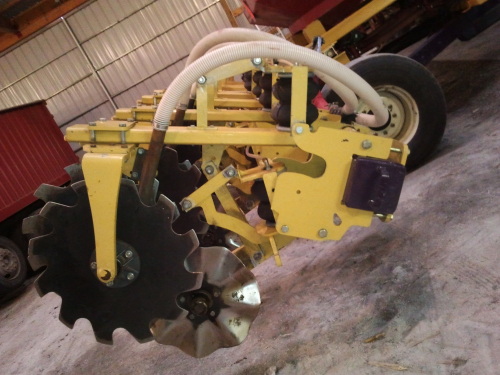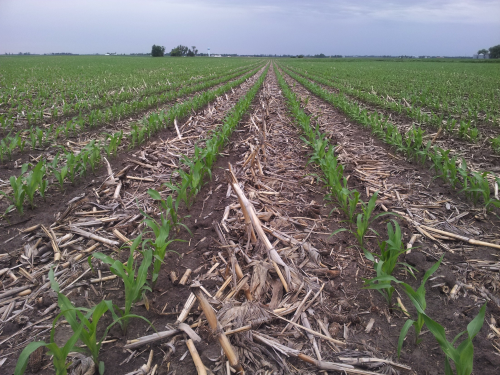Setup For Success: Newton, Iowa, strip-tiller Will Cannon recommends using a “smart” precision display with task controller functions to manage seed an fertilizer inputs. As farming operations become more prescriptive, he wants to use those tools, without having to spend money adapting technology.
Newton, Iowa, strip-tiller Will Cannon offers experienced-based insights on precision farming practices that are essential to strip-till success.
Strip-tiller Will Cannon has a more intimate knowledge of precision farming technology than most farmers.
Setup For Success: Newton, Iowa, strip-tiller Will Cannon recommends using a “smart” precision display with task controller functions to manage seed an fertilizer inputs. As farming operations become more prescriptive, he wants to use those tools, without having to spend money adapting technology.
He recently returned home full-time to the family farm in Newton, Iowa, where they raise corn and soybeans on about 500 acres. Cannon also does custom GPS mapping of precision farming data for local farmers, and he previously served as a product support specialist with Ag Leader Technology.
Cannon’s main objective has been to marry the conservation benefits of no-till systems with the potential of higher yields through targeted fertilizer placement and precision technology available with strip-till.
Cannon averages 160 and 190 bushels per acre on his strip-tilled corn-on-corn acres, and typically over 200 bushels per acre on strip-tilled corn after soybean acres. He uses an 12-row Environmental Tillage Systems Soil Warrior strip-till rig.
“We’ve been able to get as high as 270 bushels in one field in 2011, and even in the drought year of 2012 we were 173 bushels per acre on very dry soils,” he says. “Strip-till has definitely kept our yields close to or better than what we’d seen with other tillage practices.”
A key component of Cannon’s success has been his investment and experimentation with precision technology, which he says strip-tillers should take full advantage of to maximize efficiency and profitability.
Based on his experiences in the field, Cannon shared some tips and advice on choosing and incorporating precision-farming strategies that can enhance strip-till results.
1. Steering Toward Efficiency
Most strip-tillers understand the value of a reliable auto-steer system on their tractor, but Cannon says there are different tiers of performance that can affect accuracy.
“For strip-till, don’t even consider manual guidance,” he says. “You want it to be automatic because you can’t afford to be wandering when making those strips.”
Assisted steering is an fairly economical auto-steering option. These systems connect to the steering wheel of a tractor and have instrumentation built-in to guide the machine. Assuming strip-tillers have a monitor in place, assisted-steering systems can cost $3,000 to $4,000 to incorporate, and another $1,500 to $3,000 for a GPS receiver, Cannon says.
However, one drawback to assisted steering is that on hillsides or rolling terrain, these systems can struggle to maintain accuracy. For strip-till, Cannon recommends integrated-steering systems to ensure repeated accuracy regardless of terrain.
“These are going to be your Cadillac models, and with RTK and a base station it can cost $12,000 to $20,000. But the big difference is there’s a lot more sensors on these systems so they feel which direction the tractor is going, even without the GPS,” he says. “It can tell how it’s pitched and it can tell forward and back. That’s really what you need when you're trying to make sure you’ve got that repeatability in strip-till.”
Cannon uses an Ag Leader ParaDyme integrated-steering system on his Case IH MX285 tractor with Iowa’s Continuously Operating Reference Stations Network (CORS) for RTK to pull his strip-till rig.
One benefit of this system for Cannon is that it removes “guess work” when loading guidance lines each year.
“A problem strip-tillers run into with lower-quality GPS is they load that gold-standard pattern, engage the auto-steer, drive a little ways and then have to keep checking to make sure they’re on the strip,” he says. “If they’re not, they have to nudge that line to compensate, and that just wastes time.”
Another consideration when choosing an auto-steer system is whether to include rate control. Cannon says strip-tillers often ask if this is necessary.
“Some people say strip-till is just about the tillage and that’s all they’re worried about, so maybe only guidance is needed,” he says. “For me, it’s about placement of fertilizer and banding it in the strip. If I’m going to spend the money on a quality auto-steer system, it’s going to have rate control as well.”
Cannon manages one farm where the previous owner had depleted the phosphorus levels down to 5 parts per million and the potassium levels were at 70 parts per million. This past year, he applied removal rates of potassium and phosphorus in those fields, based on soil-test results, for a 220-bushel-an-acre corn yield.
“We ended up yielding near 225 bushels per acre,” he says. “I feel pretty strongly that the placement of that fertilizer, especially in low-fertility conditions, is really making a difference for me.”
Through his auto-guidance system, Cannon has rate-control capabilities on his strip-till rig and planter, but he’s seen some strip-tillers rate control five or six different products on their strip-till rig.
“I think for strip tilling you need at least of three channels of control — and honestly, I think five or more is an advantage,” Cannon says. “I’m still playing with this in my own strip-till system, but as I build more management zones based on yield history, I’ll be utilizing more variable-rate fertilizing prescriptions to feed those crops.”
2. Picking A Smart Display
When picking a display module, Cannon says a key component is functionality, and there are different tiers available.

Guided Strip-Till: Cannon utilizes an Ag Leader ParaDyme integrated steering system on his Case IH MX285 tractor with Iowa’s Continuously Operating Reference Stations Network (CORS) for RTK to pull his strip-till rig. One benefit of the integrated system for Cannon, is that it removes “guess work” when loading guidance lines each year. Photo courtesy of Will Cannon
Guided Strip-Till: Cannon utilizes an Ag Leader ParaDyme integrated steering system on his Case IH MX285 tractor with Iowa’s Continuously Operating Reference Stations Network (CORS) for RTK to pull his strip-till rig. One benefit of the integrated system for Cannon, is that it removes “guess work” when loading guidance lines each year.
A virtual-terminal display is essentially a “TV screen” showing the operator implement performance and allowing manual rate control. Cannon recommends investing in “smart” displays with task controller support, because they offer advanced integration of equipment through ISOBUS connections, and also allow strip-tillers more automated options to manage seed and fertilizer inputs.
“With strip-till, a big goal is to be more efficient with fertilizer application. To to run a prescription for the field, you’ll need to have task-controller support for it to work,” Cannon says. “With the task controller, it’s a two-way conversation and you can hopefully connect a red display to a green planter.”
Even if a strip-tiller isn’t using the task-controller function today, Cannon says, within 5 years, all displays will likely be integrated with ISOBUS capabilities.
Cannon partnered with a fellow farmer to buy a new 16-row Kinze 4900 planter for this spring with ISOBUS capabilities to run auto-swath, and variable-rate seeding through the Ag Leader Integra display in his Case IH tractor.
As farming operations become more prescriptive and targeted to match seed populations with soil types, or fertilizer with yield goals, Cannon says he wants to position himself to take advantage of those opportunities, without having to spend money continuously adapting technology.
“If I’d had an older display, or one that didn’t have task-controller support, that would have wreaked havoc on my whole strip-till system,” he says. “I would have had to answer an expensive set of questions.”
3. Making Use Of Precision Data
Another critical component of advancing a strip-till system, Cannon says, is using precision data to make better onfarm decisions.

Data Driven Field: Cannon has been collecting yield data for nearly a decade and recently began creating management zones, to evaluate trends in the field and compare yield differentials. What’s he learned is 30 or 40 bushel per acre yield differentials are due to either water drainage issues or low pH levels. Photo courtesy of Will Cannon
Data Driven Field: Cannon has been collecting yield data for nearly a decade and recently began creating management zones, to evaluate trends in the field and compare yield differentials. What’s he learned is 30 or 40 bushel per acre yield differentials are due to either water drainage issues or low pH levels.
He’s been collecting yield data for nearly a decade and recently began using it to create management zones to evaluate trends in fields and compare yield differentials.
“What I’ve learned so far is that the causes for those 30- or 40-bushel-per-acre yield differentials are either water drainage issues, or the pH levels are way off on rented land where nutrient levels had been depleted over time,” he says. “I bought a tile plow 2 years ago for pattern tiling and I estimate it will take 2 to 3 years to pay for itself because those fields will show yield improvements due to better water infiltration.”
Another reason strip-tillers should make data collection and analysis a priority, he says, is because it can simplify field operations. The emergence of wireless data transfer software is making uploading of A-B lines more seamless for tech-savvy operators.
Cannon says he’s shared plenty of horror stories with strip-tillers who have mismanaged guidance lines when transferring a USB stick from one tractor to another.
“I can speak first hand that managing those lines and moving that data from the strip-till tractor to the planter tractor can be really aggravating,” he says. “There’s a lot of time wasted or one operator doesn’t have a certain line yet and starts running in the field.
“Wireless data transfer will give those guys the ability to start synching displays. We’ll be able to make sure we’re always on those lines as they change or evolve, or have to be amended, because that information is automatically being updated to the other displays.”






